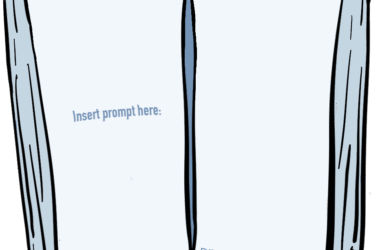 Holly Stewart
Holly Stewart Holly Stewart
Holly StewartFew hipsters, biking furiously down St. Urbain Street in Mile End, notice number 5257, an unassuming second-floor apartment in a small, pinkish-beige brick building on the east side of the street. It’s uglier and noticeably younger than other buildings on the block, with no sign to commemorate its place in Canadian literary history as the boyhood home of Mordecai Richler.
Up and down this street, the young Richler walked and the old Richler—to his great delight—drove. A few blocks down is Baron Byng High School, where he gave 10-minute speeches about current events to his peers each day and was president of his class; a block over is the famous Wilensky’s Light Lunch, which young Richler guiltily frequented and where old Richler triumphantly returned to make films based on his novels; close, too, is Fletcher’s Field, now Jeanne-Mance Park, where Richler brought girls to “neck” in the bushes – whatever that means. The streets of the Mile End are infused with the lingering spirit of Richler and the Montreal Jewish community he immortalized in his books.
“Richler’s Montreal is still here,” says Charles Foran, author of a monumental Richler biography, Mordecai: The Life and Times, published by Knopf Canada last month.
The book begins with an expansive portrait of the Montreal Jewish community at the time of Richler’s birth in 1931. Foran, who, upon moving to Montreal as a young man, chose to live on Esplanade Street because it was “Richler country,” says he asked veterans of the community to show him around the neighbourhood, to say “this was the pool hall, this was where we bought our hot dogs, this was the shul, this was the this, that was the that.”
“It hasn’t been leveled,” he says. “There haven’t been any wars or urban renewal or anything. It’s still there.”
In recent months there’s been a notable surge in Richler-related activity. There’s the book by Foran, which, though the author concedes that no biography can be truly authoritative, will surely rank as the definitive work on Richler for many years to come. In October, the Walrus, a Canadian literary magazine, put Richler on its cover (cigarette in hand, as always) with an accompanying story by his son, Noah, who’s also a writer. This December a film adaptation of Barney’s Version, the last novel Richler penned before he died will be released starring Dustin Hoffman and Paul Giamatti, presumably drawing renewed—and maybe, finally, American—interest in his works. And in the past few weeks a debate has erupted in the local media as to how Montreal should commemorate its most famous writer.
Richler’s widow, Florence, has suggested renaming St. Urbain Street after her husband. Others have proposed Fairmount Avenue, home to Wilensky’s, and only a few metres from the old Richler home.
“I think it’s borderline criminal that there isn’t a street named after him already,” says Robert Lantos, the producer of Barney’s Version and a previous Richler film, 1985’s Joshua Then and Now. “It should be Sherbrooke Street, nothing less. Mordecai Richler Avenue.”
Foran, however, isn’t sure Richler would want St. Urbain or any other street name changed. He proposes changing the Mile End Public Library into the Mordecai Richler Library, following the model set by the city of Lachine, which christened the Saul Bellow Library after another world famous Jewish novelist born in Montreal.
This type of commemoration, Foran contends, more than the renaming of a street Richler played on as a child and immortalized as an adult in his fiction, would connect Richler forever to Montreal.
“He was a writer who needed to know the soil,” Foran says. “He needed to know the soil beneath his feet.”
After graduating from Baron Byng, Richler attended and then dropped out of Sir George Williams College, now Concordia University, and moved to Europe to become a writer. Montreal was the city he couldn’t wait to leave but couldn’t forget once he was gone. Despite his nearly 20-year residence in London, England, all of Richler’s major works—The Apprenticeship of Duddy Kravitz, St. Urbain’s Horseman, Joshua Then and Now, and Barney’s Version—are set in and around Montreal.
“He was a quintessential Montrealer,” Foran says. “Like him or not, agree with him or not, he defended his Montreal, his conception of Montreal—what it was, what it should be, what it shouldn’t be.”
Indeed, Richler wrestled with the city of his birth in both his fiction and his life. Explaining his return to Montreal in 1972, Richler said he worried “about being so long away from the roots of my discontent.”
He criticized the city and his Jewish community endlessly, but never denied his origins or pretended to be anything other than a St. Urbain street boy.
“In no small part, he was such a loyal son to the city because of his childhood in that neighbourhood,” Foran says. “It kind of held him; it nurtured this very distinctive, outsized personality. Jewish Montrealers, who were sort of the first people he exercised his muscles on, they got this kid—this bratty, angry, smart, iconoclastic kid. Judaism has this tradition of provocation and people asking hard questions, and Richler took on that role.”
In this sense, the Richler story is very much the Montreal story. Both represent a heritage of internal contradiction, ceaseless dialectic, and rabid self-criticism.
Foran presents this idea as a substantial theme of his book. “I think Montreal is a naturally combative city,” he says. “There are different narratives, and different histories, and it’s all on the same ground.”
Cities are monuments to irresolution. The changing skyline, the perpetual construction, social and cultural transformations, daily turmoil—the city is the quintessential embodiment of a “work in progress.” Humans, like most creatures, inhabit the spaces our ancestors constructed; and we, too, continue to build.
Montreal has always taken this principle of irresolution to the extreme. It represents hundreds of years of argument, negotiation, and constant battle. It has always promised to be different things to different people, and its famed dynamism is the result of this ceaseless negotiation.
Richler’s refusal to compromise himself and his principles—especially what Foran called “his conception of Montreal”—eventually got him in a lot of trouble. After the publication of Oh Canada Oh Quebec! in 1992, outlining his ideas about Quebec separatism and odious language laws, Richler became a persona non grata for many Francophones in the province. He was and is still regularly called a racist, a bigot, and a fraud. His list of enemies is long, and many of them are not ready to let Montreal commemorate a man they consider to be an enemy to their city and to La Belle Province.
Robert Lantos, the producer of Barney’s Version, has his own ideas about Richler’s legacy.
“I suspect that there isn’t anyone who has done as much for Montreal in terms of world literature than Mordecai has,” he says.
But of course not everyone agrees. Richler’s Montreal is not the only Montreal. Foran believes that Francophones living in Brossard or Laval “just don’t know what we’re talking about.”
Indeed, Macha Grenon, a famous Quebec actress who plays a supporting role in Barney’s Version, admits that Richler represents only a part of the Montreal experience.
“Of course I’d heard of Mordecai Richler, but to be honest I only came to know that whole universe through Barney’s Version,” she says. “It was fascinating to me, because so much of it was about the neighbourhood I grew up in, and it’s amazing to read and to realize how unaware you can be of somewhere you’ve been living your whole life.”
Even so, Grenon is excited by the major role the city itself plays in the new film. Whereas many filmm
akers use Montreal for films set elsewhere—as with the upcoming production of Jack Kerouac’s On the Road, which is being filmed here but is set in late 1940s Denver—Barney’s Version is securely placed in Montreal. The characters stroll in Square St. Louis, drink in a bar on St. Catherine streets, try to kick a drug habit while staying on the Lower Main, and make off-hand references to St. Viateur bagels and even our own eminent university.
“Someone not from Montreal or Canada will really enjoy the film,” Grenon says. “But I think for Montrealers and Canadians you’re on the inside of it, you really get to recognize things, and Montreal finally gets the stardom it deserves.”
Perhaps in this way Richler will posthumously be recognized as a quintessentially Montreal artist, who, while alternating between celebrating and criticizing his home city, created in his fiction a singular monument to its complexity and unique sense of itself.
“Richler really took a stab at everyone,” says Anna Hopkins, also a native Montrealer, who plays the title character’s daughter in Barney’s Version. “I think that’s really characteristic of Montreal in general. Self-criticism – big time.”
“Richler was never at ease in the world,” Foran says. And, arguably, neither is Montreal, the city he never really left and which, to the end, never left him.






